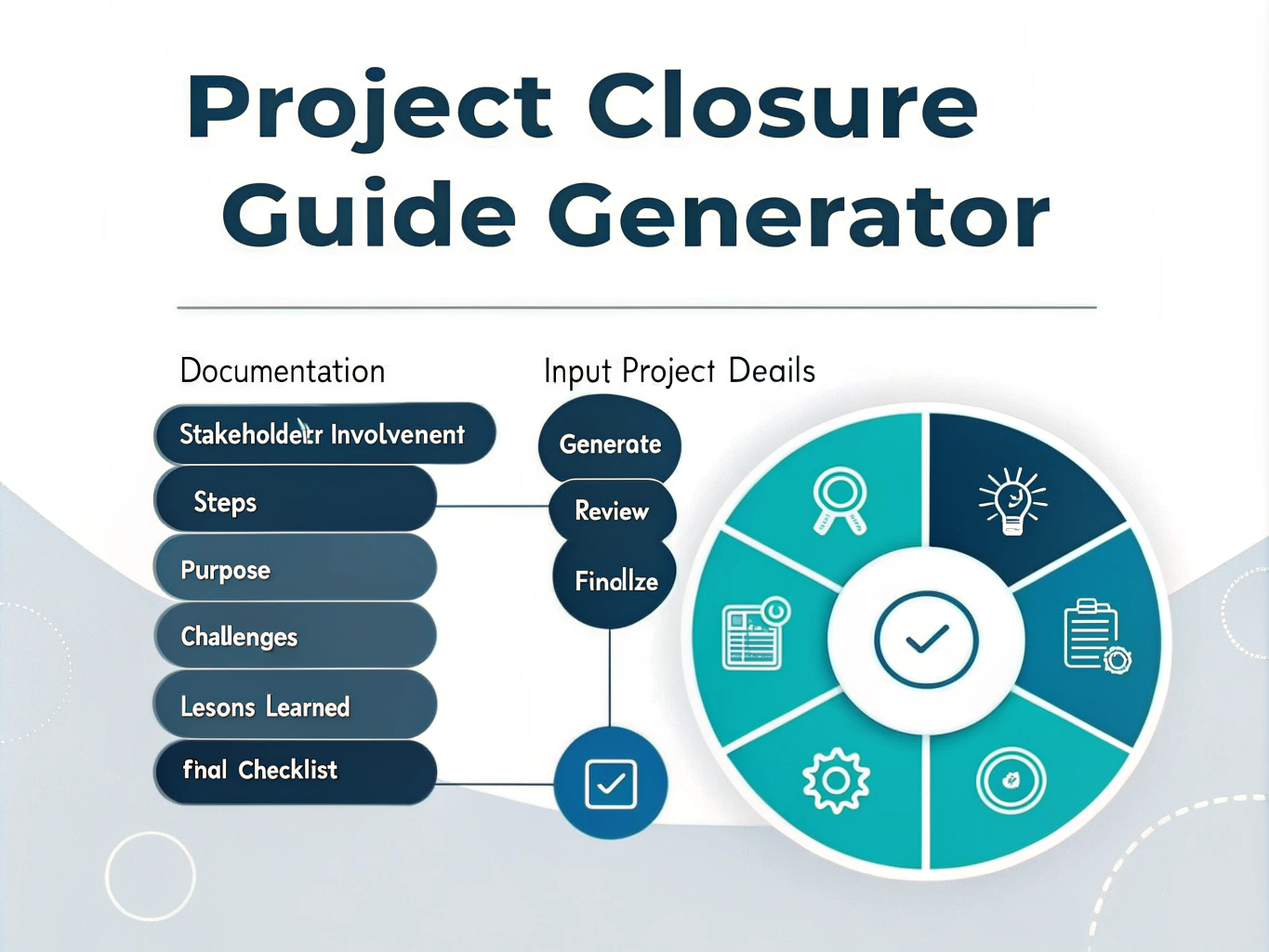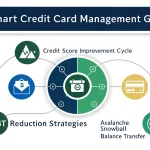Is this tool helpful?
How to Use the Project Closure Guide Generator Effectively
The Project Closure Guide Generator helps you create a tailored project wrap-up plan. Follow these steps to get the most accurate and useful guide for your project:
- Enter the Project Type (Optional): Specify your project’s category. For example, you could input “Renewable Energy Installation” or “Non-Profit Fundraising Event”. This helps the tool tailor recommendations relevant to your field.
- Specify the Project Size (Optional): Choose the scale of your project. Examples include “Pilot Program” or “Regional Expansion”. This guides the scope and complexity of closure steps.
- Add Industry-Specific Considerations (Optional): Include relevant factors unique to your sector. For instance, you might mention “Environmental impact assessment” or “FDA regulatory compliance”. This ensures your guide addresses critical sector-specific requirements.
- Generate the Guide: Click the Generate Project Closure Guide button to produce a customized closure plan based on your inputs.
- Review and Use the Guide: Examine the generated guide carefully. You can copy the content and use it to support your project closure documentation or team discussions.
Providing more detailed information results in a more precise and actionable project closure guide tailored to your unique project.
What is the Project Closure Guide Generator? Definition, Purpose, and Benefits
Definition
The Project Closure Guide Generator is a user-friendly online tool designed to help project managers and teams produce detailed and customized project closure plans. By considering factors such as project type, size, and industry nuances, the tool creates a structured roadmap that ensures nothing important is overlooked when closing a project.
Purpose
This tool aims to assist you in completing your project closure effectively and efficiently. It helps you:
- Identify and complete essential closure activities
- Ensure proper documentation of results and lessons learned
- Organize the release of resources and formal acceptance by stakeholders
- Standardize project closure processes across your organization
- Protect against risks associated with incomplete project wrap-ups
Benefits
Using this guide generator provides multiple advantages that improve your project wrap-up process:
- Save Time: Quickly generate a comprehensive guide without researching closure best practices yourself.
- Tailored Guidance: Receive recommendations that reflect your specific project’s characteristics and industry.
- Full Coverage: Avoid missing critical closure steps by following a thorough, structured plan.
- Apply Best Practices: Use guidance grounded in recognized project management standards.
- Support Consistency: Ensure your projects close out smoothly and uniformly across teams.
- Capture Lessons: Facilitate knowledge transfer and continuous improvement within your organization.
- Mitigate Risks: Reduce chances of unfinished tasks or unresolved issues affecting your project’s final success.
- Improve Stakeholder Satisfaction: Deliver a polished and complete project handover that strengthens relationships.
Practical Uses of the Project Closure Guide Generator
This tool is versatile and adapts to various projects, helping you customize closure processes based on your needs. Here are examples that demonstrate its practical applications across industries and project scales:
Large-Scale Infrastructure Project
- Verify compliance with safety and environmental regulations.
- Confirm completion of all construction milestones.
- Handover operational manuals and certifications.
- Ensure final inspections and stakeholder approvals.
- Document cost reconciliation and lessons learned.
Small Creative Campaign
- Review campaign deliverables and client feedback.
- Archive creative assets and performance metrics.
- Ensure intellectual property rights are clearly documented.
- Outline client approval and project close communication.
- Gather lessons learned for future campaigns.
Healthcare Research Study
- Archive patient data securely and ensure privacy compliance.
- Complete regulatory reporting and documentation.
- Prepare final study results and publication materials.
- Conduct post-study reviews and knowledge sharing.
- Plan resource redeployment and project closure announcements.
Software Development Project
- Finalize code documentation and user manuals.
- Complete deployment and acceptance testing steps.
- Document maintenance plans and support handover.
- Conduct release retrospectives and share lessons learned.
- Confirm closure sign-offs with stakeholders.
These examples show how you can adapt the tool to different project types, ensuring you cover all important closure activities relevant to your context.
Key Elements Included in Your Project Closure Guide
The generated guide typically includes the following core components that help you wrap up your project systematically:
1. Purpose and Importance of Project Closure
Understand why closing your project properly matters and the positive impact it has on your team and organization.
2. Step-by-Step Closure Process
A clear sequence of necessary closure activities such as:
- Completing all project deliverables and tasks
- Handing over outputs to clients or stakeholders
- Releasing project teams and resources
- Obtaining formal approvals and sign-offs
3. Documentation and Reporting
Details on required documents like project closure reports, lessons learned documents, and final performance summaries.
4. Stakeholder Engagement
Guidance on communicating closure steps, conducting meetings, and managing expectations during the handover phase.
5. Common Challenges and Solutions
Insights on frequent issues such as scope creep or incomplete deliverables and practical advice to overcome them.
6. Lessons Learned Process
Structured approaches for capturing and sharing valuable insights gained during the project to improve future performance.
7. Final Closure Checklist
A comprehensive list ensuring every vital task is completed before you officially close your project.
Adapting the Project Closure Guide for Different Industries
This tool highlights industry-specific needs to provide relevant closure guidance tailored to your sector. Here are some examples:
Information Technology
- Software deployment and environment shutdown procedures
- Data backup and migration protocols
- User acceptance and system documentation
- Intellectual property and licensing details
- Support handover and training plans
Construction
- Final inspections and quality certifications
- Handover of blueprints and operation manuals
- Warranty and maintenance agreements
- Site clean-up and environmental compliance
- Health and safety documentation
Marketing and Advertising
- Performance review and reporting
- Client feedback and approval process
- Archival of creative assets and research data
- Clarifying intellectual property rights
- Planning for ongoing client relationships
Healthcare
- Patient data privacy and compliance measures
- Clinical trial record archiving
- Regulatory documentation submission
- Equipment disposal and decommissioning
- Post-project monitoring and evaluation plans
Maximizing the Value of the Project Closure Guide Generator
To get the most from this generator, follow these best practices:
1. Provide Detailed Inputs
The more specific your project description and industry considerations, the more relevant your guide will be.
2. Customize the Generated Guide
Use the guide as a foundation but adapt it further to your project’s unique context and organizational standards.
3. Share Across Your Team
Distribute the guide to all stakeholders involved in project closure to promote alignment and accountability.
4. Use as a Learning Tool
Leverage the lessons learned section to improve future projects and refine your project management processes.
5. Maintain Consistency
Apply the guide’s structured approach consistently across projects to enhance efficiency and quality in your project closures.
Important Disclaimer
The calculations, results, and content provided by our tools are not guaranteed to be accurate, complete, or reliable. Users are responsible for verifying and interpreting the results. Our content and tools may contain errors, biases, or inconsistencies. Do not enter personal data, sensitive information, or personally identifiable information in our web forms or tools. Such data entry violates our terms of service and may result in unauthorized disclosure to third parties. We reserve the right to save inputs and outputs from our tools for the purposes of error debugging, bias identification, and performance improvement. External companies providing AI models used in our tools may also save and process data in accordance with their own policies. By using our tools, you consent to this data collection and processing. We reserve the right to limit the usage of our tools based on current usability factors.







